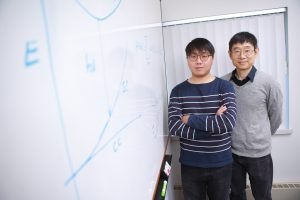Dec 5 2018
Physicists at The University of Toledo are part of an international team of researchers who discovered a single material that yields white light, paving the way to a new frontier in lighting, which accounts for one-fifth of world’s energy consumption.
 Dr. Xiaoming Wang, left, and Dr. Yanfa Yan, right. (Image credit: The University of Toledo)
Dr. Xiaoming Wang, left, and Dr. Yanfa Yan, right. (Image credit: The University of Toledo)
“Due to its high efficiency, this new material can potentially replace the current phosphors used in LED lights—eliminating the blue-tinged hue—and save energy,” said Dr. Yanfa Yan, professor of physics at UT. “More research needs to be done before it can be applied to consumer products, but the ability to reduce the power that bulbs consume and improve the color quality of light that the bulbs emit is a positive step to making the future more environmentally friendly.”
Recently, the renewable energy study was published in Nature, the world’s leading multidisciplinary science journal.
The equation to create the inorganic compound integrates a lead-free double perovskite with sodium.
Together, cesium, silver, indium, and chloride emit white light, but the efficiency is very low and not usable. When you incorporate sodium, the efficiency increases dramatically. However, when sodium concentration reaches beyond 40 percent, side effects occur and the white light emission efficiency starts to drop below the peak of 86 percent.
Dr. Yanfa Yan, Professor of Physics, The University of Toledo
Aided by the U.S. Department of Energy’s Energy Frontier Research Center in Colorado known as CHOISE, Yan and Dr. Xiaoming Wang, UT post-doctoral researcher, conducted the theoretical calculations that exposed why the new material produced through experiments by a team led by Dr. Jiang Tang at Huazhong University of Science and Technology in China yields high-efficiency white light.
“It was a wonderful experience working with Dr. Wang and Dr. Yan. Their professional theoretical simulation helps to reveal the emission mechanism of this miracle material,” said Tang, professor at Huazhong University of Science and Technology’s Wuhan National Laboratory. “This lead-free all-inorganic perovskite not only emits stable and efficient warm-white light that finds itself useful for solid-state lighting, but also shows as an encouraging example that lead-free perovskites could even show better performance than their lead cousins.”
“Their work is truly impressive,” Dr. Sanjay Khare, professor and chair of the UT Department of Physics and Astronomy, said. “Emission of white light from a single material is likely to open a whole new field in opto-electronics.”
Monash University, Jilin University, University of Toronto, Tsinghua University, Chinese Academy of Sciences and Wuhan University also contributed to the study.